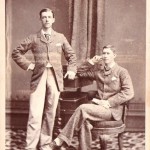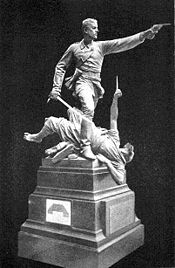Lt Walter Hamilton VC.
Larry Scallan
Kilkenny Military Heritage Project
The study of military history allows the reader to analyse and critique the decisions of the commanders of past campaigns with the benefit of hindsight and 360 degree vision; it’s easy to see where fundamental mistakes were made. Unfortunately commanders on the ground rarely have the complete picture of what threats they are facing and an astute enemy will be using all available resources available to him to introduce the fog of war unto the battle space.
Assets available to the 21st Century commander even at section level would have astounded divisional staff officers at the end of the Victorian era. A sniper pair armed with a specialist rifle can surgically remove a strategic target from the battlefield from over 2.4 kilometres away , one shot one kill, combined with the ability to vanish without trace exemplifies this. Laser range finders, computerised calculations for indirect fire weapons are now basic items of kit available to insure the optimum killing potential is achieved at all times. Soldiers are now very far removed from engaging enemies in hand to hand combat. Often the enemy is a flashing dot on a computer screen and the trigger pressed is more like a joy pad button than a trigger within which the gentle squeeze of the trigger finger sends a piece of lead towards a visible enemy within range of a rifle man.
On any parade where soldiers of the Irish Defence Forces are present, it quickly becomes apparent that the vast overseas service expressed by the varied medals representing missions from 1950s, right through to the present are in reality a visible expression of the immense corporate and specialist expertise available to our government when the international requirement arises. Even though it’s often the expert individual soldiers who are put forward as being our most essential resources, in reality it’s the moral courage and impartial professional behaviour of even our youngest soldiers who have been immersed in the culture of uniformed life from enlistment which really sways the day.
This desire for uniformed life is by no means a new phenomenon in Irish history. In 1798 five short years after the embodiment of the Irish Militia, Irish men wearing the Kings uniform were chiefly responsible for putting down the insurrection , almost all of the thirty eight militia regiments were involved throughout the period, in fact 68% of all soldiers operating in Ireland during 1798 were Irish militia. The argument being made is that throughout Irish military history once a man has accepted a life in uniform he will then honour his word and obey his superior Officers and look after his comrades to the point of giving his life to preserve theirs. Pte John Barry VC Royal Irish Regiment being a prime example .
This devotion of military life can start to explain why so many Irish born solders have won the Victoria Cross, the highest award available to soldiers in the Crown forces of all ranks since the Crimean war. One such soldier is Walter Hamilton. The winning of the VC by Lt Walter Pollack-Hamilton of Queen Victoria’s corps of Guides in 1879 and how he lost his life shortly afterwards is an exceptional story. His story surely ranks amongst the most significant throughout the history of Irish men and women in service in the forces. Sir Charles Macgregor, as president of the Committee appointed to enquire into the causes of the events surrounding the slaying of Sir Louis Cavignari, Lt Hamilton VC and his escort; Stated that-
The annals of no army and no regiment can show a brighter record of devoted bravery than has been achieved by this small band of Guides. By their deeds they have conferred undying honour, not only on the regiment to which they belong, but on the whole British Army. The conduct of the escort of the Queen’s Own Corps of Guides does not form part of the enquiry entrusted to the Commission, but they have in the course of their enquiries had the extreme gallantry of the bearing of these men so forcibly brought to their notice that they cannot refrain from placing on record their humble tribute of admiration .
Walter Hamilton was born on the 18th August 1856 the Fourth son of Alexander and Emma Hamilton, of Instigoe a small village fifteen miles south of Kilkenny city. He entered the 70th (Surry) Regiment of Foot as a Lieutenant in 1874 aged 18 years, but by 28 February that year he had transferred into Queen Victoria’s Corps of Guides part of the Bengal staff corps.
The Bengal Army, Madras Army, and Bombay Army were quite distinct, while they formed the army of the honourable East India Company each with its own Regiments and cadre of European officers. All three armies contained European regiments in which both the officers and men were Europeans, as well as a larger number of ‘Native’ regiments, in which the officers were Europeans and the other ranks were Indians. It is well documented that the armies was so far removed from the control of Horse Guards that there was little if any direct operational command enforced by London over these units. The command structure was very much directed by the Presidency’s which in turn reported the Crown.
On 2nd of April 1879 a small force under General Charles Gough was on the road from Jallalabad to Kabul when they were threatened by a large force of Afgan tribesmen. With covering fire from the horse artillery, the Guides cavalry and 10th Hussars were ordered to attack. The Guides were commanded by Major Wigram Battye, but he was shot in the hip early on and walked his horse as the rest charged on. He was shot again, this time fatally and the charge, now led by Lieutenant Walter Hamilton gathered momentum over difficult stony ground. The enemy were well placed to receive a charge because there was a 9ft deep dry gully just in front of them, but the Guides were going too fast to avoid it and plunged down the steep drop and on towards the tribesmen firing at them from the top of the other bank. The enemy were unnerved and fell back as Hamilton and his screaming sowars (Indian cavalry) stormed up the slope and cut through them. In the fight Hamilton saw a fallen sowar trapped under his horse being set upon by three tribesmen. He leapt to his rescue, dealing with the three men and helping the trapped man. He then led the guides to victory routing the tribesmen. The Guides lost 20 men and 37 horses while Afghan losses were put at 400 . Hamilton would be recommended for the VC as a result of this action. At the time only British soldiers could win the VC, the highest award for Indian soldiers was the Order of Merit which was won by six of them during the action.
Lt Hamilton would lead his Unit to Kabul where there were ongoing political decisions were being made. The events and actions carried out by Lt Hamilton will be contained in Part to


